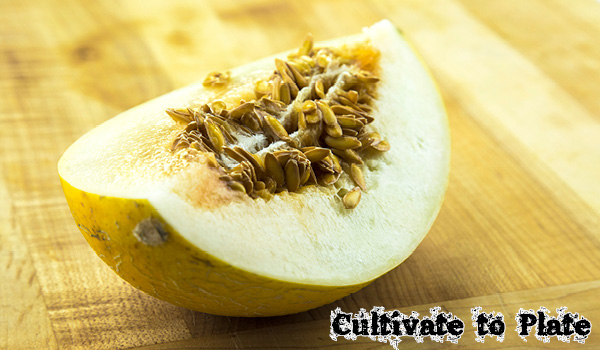Summer Melons: Tips for Choosing the Perfect One
Melons are a thirst-quenching treat: on a hot day, nothing refreshes quite like fresh, ripe melon. And while they are found year round via imports at the market, the peak time for harvest in the garden or farmers markets for most summer varieties is in the middle of the summer.
All ripe melon is great when chilled, but flavors truly develop when served at room temperature. Melons uncut, whole, may be stored at room temperature until they are ready to eat. But keep in mind that all cut melon should be eaten soon after being cut. Read below for FDA guidelines on the proper ways to handle melons.
Eating a ripe melon can be a wonderful, almost ethereal experience with its floral aroma and natural sweetness, or it can be a total disappointment, all depending if you choose a ripe one or not. Here are some tips for choosing the perfect melon.
Choosing the Perfect Melon
Melons are grouped into three major groups: muskmelons with netted skins, like cantaloupes; muskmelons with smooth, wrinkled, or gnarled skins, such as honeydew and Santa Claus; and watermelon, which technically aren’t even a true ‘melon’ (they are botanically a berry). All melons are typically picked by ripeness as opposed to size.
Muskmelon with Netted Skins
Cantaloupe, Persian Melons – These melons have the characteristic ‘net’ covering over their rind.
- Look for cantaloupe with no stem pieces sticking out of the end. A smooth cut end generally means it was cut from the vine at the proper time. This should be free of decay or bruising.
- Opposite the stem is the blossom end, and this should be free of decay or bruising as well. When ripe, it will give slightly when pressed.
- The netting on the outside should be well defined, cream-colored, and free of bruising. But don’t rely on what the rind color is: some varieties of cantaloupe will remain green or slightly green even when fully ripe.
- It is normal for cantaloupe to be lighter in color on one side and darker on the opposite. This just shows where the cantaloupe has touched the ground as it grew in the fields.
- A cantaloupe will give off a characteristic melon aroma when it is ripe, and can transfer to other foods. Conversely, it can pick up other smells from foods in the cooler so keep cantaloupes separate from delicate foods or strongly flavored foods.
- Cantaloupes continue to ripen at room temperatures so if you are not going to serve a fresh melon when it is ripe, refrigerate it.
Muskmelons with Smooth, Wrinkled, or Gnarled Skins
Canary, Casaba, Honeydew, Santa Claus. These melons range widely in rind texture and color. These melons are come in small to very large, are found with different color hues for the flesh.
- Pick it up – this type of muskmelon, when ripe, will feel heavy for its size.
- The skins should be almost silken to velvet in texture even when gnarled.
- Look at both ends. The stem end should be smooth and free of decay or bruising. The blossom ends should give slightly when pressed.
- Honeydews when they are fully ripe will have a natural ‘stickiness’ to their rinds. This is the fruit sugar from the melon coming to the surface.
- These melons will also give off a strong, sweet melon aroma when ripe.
- Honeydew melons will continue to ripen if left on the counter at room temperature, so put fully ripened honeydews in the cooler away from strong odors.
Watermelon
- For all varieties (large, mini, specialty, and different colored flesh), look for smooth rinds with no soft spots. Avoid those with cuts along the sides or ends, or those with cracks. Also avoid watermelons with bruises.
- Lift it up and feel its weight. A fully ripe watermelon will feel heavy for its size.
- Turn the watermelon around and look for the area that was lying on the ground. A ripe watermelon will have cream or yellow colored spot, and a green or unripe watermelon will have a bright, white spot.
Safe Handling of Melons
The FDA recommends these guidelines for the safe handling of melon.
- Uncut melon may be stored at room temperature until cutting and serving. But inspect the melon before you cut it up. This is important when you purchase a bunch of melon on sale but did not eat it in time, or when you harvested your ripe melon all at the same time.
- Look at the rind and toss any melon that is cracked, dented, or you have a melon with soft spots or hollowing.
- Rinse off the outside rind before cutting to remove any surface dirt, and dry it off.
- Serve the melon when you cut it. Always chill any remaining melon you cut up, promptly. Also, maintain the temperature of melons: if you purchased cut melon at the store, keep it refrigerated (do not store or keep at room temperature).


You must be logged in to post a comment.